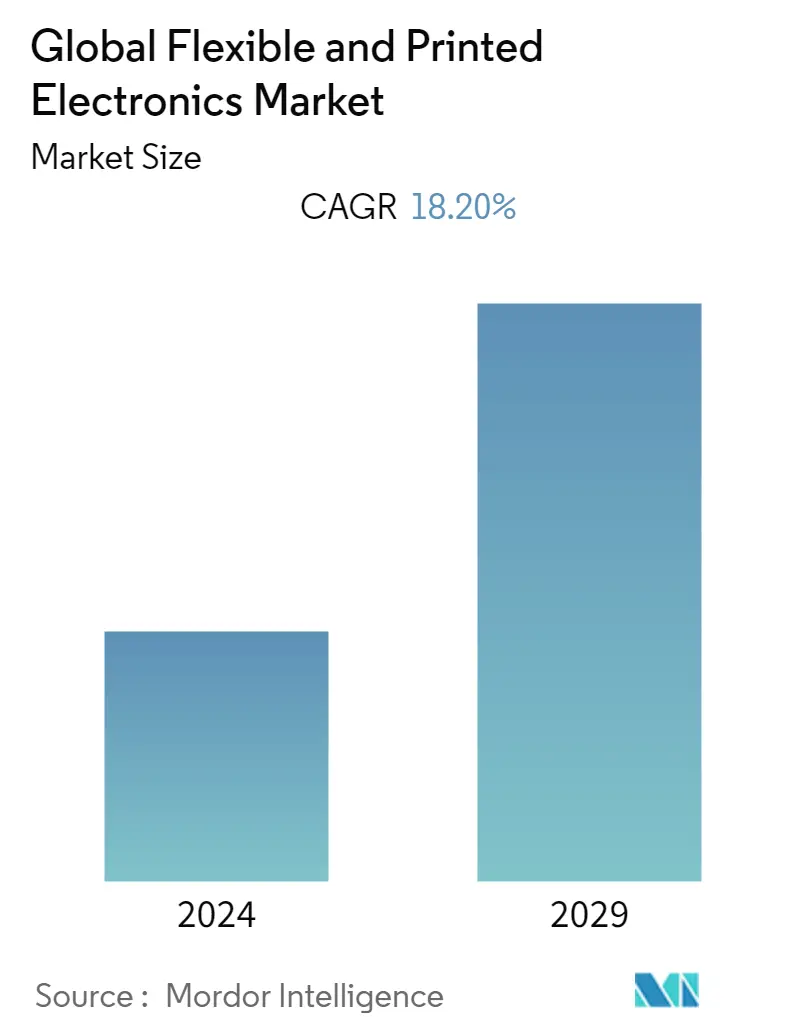Market Size of Global Flexible and Printed Electronics Industry

| Study Period | 2019 - 2029 |
| Base Year For Estimation | 2023 |
| CAGR | 18.20 % |
| Fastest Growing Market | North America |
| Largest Market | Asia-Pacific |
| Market Concentration | Medium |
Major Players
*Disclaimer: Major Players sorted in no particular order |
Flexible & Printed Electronics Market Analysis
The global Flexible and Printed Electronics Market is expected to register a CAGR of 18.2% during 2022-2027. The market is primarily driven by the rapid penetration of smart wearable and integrated electronic devices that have increased demand for advanced intelligent systems with high performance, micro size, mechanical flexibility, and high-temperature stability for use as flexible and stretchable displays, personal health monitoring, human motion capturing, smart textiles, electronic skins, and other applications.
- Electronics players in the market, such as Samsung and LG Electronics, have introduced the flexible, foldable, and rollable smartphone, display, and tablet products. Because of the rapidly aging global population and the dramatically increasing demand for in-home healthcare, wearable and mobile health monitoring technologies have recently sparked tremendous interest worldwide.
- According to BNP Media, electronic components will account for 50% of an automobile's total production cost by 2030. Earlier in the decade, it was only 30%. Thin, light, and flexible electronics advancements are driving various innovative technologies, from curved TVs to glucose-monitoring contact lenses. This could result in the development of printable solar cells and flexible screens based on organic light-emitting diodes (OLEDs).
- The electronics industry is rapidly transitioning from standard, rigid form factors to stretchable and conformable devices. Wearables for healthcare, smart packaging, sensors, automotive taillights and displays, flexible displays, photovoltaics, and other printed, flexible, and stretchable electronics products are increasing weekly.
- Furthermore, in-mold electronics (IME) and flexible sensors are expanding the application of flexible and printed electronics in smart wearable technologies. Wearable device growth, particularly smart wearable device growth, may broaden the market scope over the forecast period. Cisco predicts that the number of connected wearables will exceed 1,105 million by 2021.
- COVID-19's emergence and expansion have significantly impacted the company's position in the flexible electronics and electronics value chain. On the other hand, the market for flexible electronics has declined significantly due to global shutdowns that have resulted in the complete closure of all public places, industrial facilities, and offices.
- The COVID-19 outbreak caused major delays for electronic manufacturers, as Chinese suppliers have struggled to keep factories running at full capacity. Many electronic manufacturers in the United States and Europe rely on components manufactured in China. In February, IPC, an electronic equipment trade organization, surveyed 65% of the 150 electronic manufacturers and suppliers who participated and reported supplier delays due to the spread of COVID-19.
Flexible & Printed Electronics Industry Segmentation
The report examines the demand dynamics for flexible and printed electronics across multiple applications and geographies. The study also examines various technological advancements, emerging applications, trends, challenges and opportunities, and key vendors serving this industry.
The Global Flexible and Printed Electronics Market is segmented by Product (Displays, Conductive Ink/In-Mold Electronics (IME), Printed & Flexible Sensors, RFID Tags) and By Application (Consumer Electronics & IoT, Wearable Technology, Retail & Packaging, Healthcare, Automotive & Transportation), and Geography.
| By Product Type | |
| Displays | |
| Conductive Ink/In-Mold Electronics (IME) | |
| Printed & Flexible Sensors | |
| RFID Tags | |
| Other Applications (OLED Lighting, Batteries, OPV, E-textiles, Logic etc.,) |
| By Application | |
| Consumer Electronics & IoT | |
| Wearable Technology | |
| Retail & Packaging | |
| Healthcare | |
| Automotive & Transportation | |
| Other Applications |
| By Geography | |
| North America | |
| Europe | |
| Asia-Pacific | |
| Rest of the World |
Global Flexible and Printed Electronics Market Size Summary
The global flexible and printed electronics market is experiencing significant growth, driven by the increasing demand for advanced electronic systems that offer high performance, micro size, and mechanical flexibility. This demand is largely fueled by the proliferation of smart wearable devices and integrated electronic systems used in applications such as flexible displays, personal health monitoring, and smart textiles. The market is witnessing a shift from traditional rigid electronics to more adaptable and stretchable forms, with innovations in areas like curved displays and electronic skins. The automotive sector is also a major contributor, with electronic components becoming a larger portion of vehicle production costs, highlighting the need for thin and flexible electronics in modern vehicles. The COVID-19 pandemic has posed challenges, causing delays in supply chains and manufacturing, particularly affecting reliance on Chinese suppliers. However, the market is poised for recovery and growth as industries adapt and innovate.
The Asia-Pacific region is expected to hold a substantial share of the global printed electronics market, supported by its robust manufacturing capabilities and significant investments in research and development. The region's large population and economic potential provide a strong market for flexible electronics, with companies like Samsung and LG leading in display manufacturing. The automotive industry in APAC is also a key driver, with advancements in automotive electronics and the integration of flexible displays and OLED lighting in vehicles. Collaborations among major firms, such as Eaton Corporation and LG Electronics, are further propelling the market by enhancing energy management solutions. The market is characterized by continuous innovation, with companies investing in novel technologies to meet the growing demand for high-quality consumer electronics and smart devices.
Global Flexible and Printed Electronics Market Size - Table of Contents
-
1. MARKET INSIGHTS
-
1.1 Market Overview
-
1.2 Industry Attractiveness - Porter's Five Forces Analysis
-
1.2.1 Threat of New Entrants
-
1.2.2 Bargaining Power of Buyers/Consumers
-
1.2.3 Bargaining Power of Suppliers
-
1.2.4 Threat of Substitute Products
-
1.2.5 Intensity of Competitive Rivalry
-
-
1.3 Industry Value Chain Analysis
-
1.4 Impact of COVID-19 on the Industry
-
-
2. MARKET SEGMENTATION
-
2.1 By Product Type
-
2.1.1 Displays
-
2.1.2 Conductive Ink/In-Mold Electronics (IME)
-
2.1.3 Printed & Flexible Sensors
-
2.1.4 RFID Tags
-
2.1.5 Other Applications (OLED Lighting, Batteries, OPV, E-textiles, Logic etc.,)
-
-
2.2 By Application
-
2.2.1 Consumer Electronics & IoT
-
2.2.2 Wearable Technology
-
2.2.3 Retail & Packaging
-
2.2.4 Healthcare
-
2.2.5 Automotive & Transportation
-
2.2.6 Other Applications
-
-
2.3 By Geography
-
2.3.1 North America
-
2.3.2 Europe
-
2.3.3 Asia-Pacific
-
2.3.4 Rest of the World
-
-
Global Flexible and Printed Electronics Market Size FAQs
What is the current Global Flexible and Printed Electronics Market size?
The Global Flexible and Printed Electronics Market is projected to register a CAGR of 18.20% during the forecast period (2024-2029)
Who are the key players in Global Flexible and Printed Electronics Market?
SAMSUNG , LG Electronics, Jabil Inc., Royole Corporation and E Ink Holdings Inc are the major companies operating in the Global Flexible and Printed Electronics Market.

